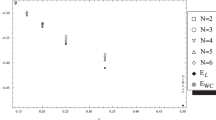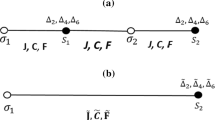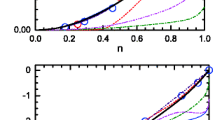Abstract
Measurements of the temperature dependences of La0.15Sm0.85MnO3 + δ magnetization in the temperature range of 4.2–100 K detected a magnetization threshold feature near the temperature Td ≅ 50 K, as-sociated with the existence of the small pseudogap Δe in the electron spectrum, characteristic of the weak Mott insulator. An increase in the external magnetic field strength H results in dielectric pseudogap Δe suppression, an increase in the density of states of free charge/spin carrier at EF, and the transformation of wave fragments of the charge/spin density. In the temperature range of 4.2–12 K, the quantization of the spectrum of pairs of low-energy magnetic excitations of Z2 quantum spin liquid is found in the form of composite spinon–gauge field quasiparticles. The formation of the continuous spectrum of quantum spin liquid excitations in the mode of “weak magnetic fields” H = 100 Oe, 350 Oe, and 1 kOe is explained within the models of Landau quantization of the spectrum of composite quasiparticles with fractional filling factors ν of three overlapping Landau bands. In the mode of the “strong external magnetic field” H = 3.5 kOe, new quantum oscillations of the temperature dependences of the magnetization of incompressible spinon liquid are detected in the form of three narrow steps (plateaus) corresponding to the complete filling of non-overlapping Landau bands with spinons with integer filling factors.














Similar content being viewed by others
REFERENCES
S. Sachdev, arXiv: 0901.4103v6 (2009).
O. I. Motrunich, Phys. Rev. B 72, 045105 (2005).
T. Senthil, Phys. Rev. B 78, 035103 (2008).
T. Senthil, Phys. Rev. B 78, 045109 (2008).
X.-G. Wen, Lectures given in the Cargese Summer School of Strongly Correlated Electron Systems, 1990.
V. Kalmeyer and R. B. Laughlin, Phys. Rev. Lett. 59, 2095 (1987).
X. G. Wen, F. Wilczek, and A. Zee, Phys. Rev. B 39, 11413 (1989).
R. B. Laughlin and Z. Zou, Phys. Rev. B 41, 664 (1990).
E. Mele, Phys. Rev. B 38, 8940 (1988).
K. V. Klitzing, G. Dorda, and M. Pepper, Phys. Rev. Lett. 45, 494 (1980).
D. C. Tsui, H. L. Stormer, and A. C. Gossard, Phys. Rev. Lett. 48, 1559 (1982).
R. B. Laughlin, Phys. Rev. B 23, 5632 (1981).
H. Aoki and T. Ando, Solid State Commun. 38, 1079 (1981).
F. D. M. Haldane, Phys. Rev. Lett. 51, 605 (1983).
R. B. Laughlin, Phys. Rev. Lett. 50, 1359 (1983).
F. D. M. Haldane, and Y.-S. Wu, Phys. Rev. Lett. 55, 2887 (1985).
F. D. M. Haldane, Phys. Rev. Lett. 67, 937 (1991).
F. Wilczek, Phys. Rev. Lett. 49, 957 (1982).
B. I. Halperin, Phys. Rev. Lett. 52, 1583 (1984).
R. B. Laughlin, Phys. Rev. Lett. 60, 2677 (1988).
F. N. Bukhanko and A. F. Bukhanko, Phys. Solid State 57, 1114 (2015).
F. N. Bukhanko and A. F. Bukhanko, Phys. Solid State 58, 519 (2016).
F. N. Bukhanko and A. F. Bukhanko, Phys. Solid State 61, 2525 (2019).
A. Kitaev, Ann. Phys. (N.Y.) 321, 2 (2006).
D. Shoenberg, Magnetic Oscillations in Metals (Cambridge Univ. Press, Cambridge, UK, 1984).
M. Y. Reizer, Phys. Rev. B 40, 11571 (1989).
P. A. Lee, Phys. Rev. Lett. 63, 680 (1989).
P. A. Lee and N. Nagaosa, Phys. Rev. B 46, 5621 (1992).
J. Polchinski, Nucl. Phys. B 422, 617 (1994).
B. L. Altshuler, L. B. Ioffe, and A. J. Millis, Phys. Rev. B 50, 14048 (1994).
C. Nayak and F. Wilczek, Nucl. Phys. B 430, 534 (1994).
Y. B. Kim, A. Furusaki, X. G. Wen, and P. A. Lee, Phys. Rev. B 50, 17917 (1994).
R. Coldea, D. A. Tennant, A. M. Tsvelik, and Z. Tylczynski, Phys. Rev. Lett. 86, 1335 (2001).
R. Coldea, D. A. Tennant, and Z. Tylczynski, Phys. Rev. B 68, 134424 (2003).
G. Baskaran, S. Mandal, and R. Shankar, Phys. Rev. Lett. 98, 247201 (2007).
H.-D. Chen and Z. Nussinov, J. Phys. A 41, 075001 (2008).
J. Reuther, R. Thomale, and S. Trebst, Phys. Rev. B 84, 100406(R) (2011).
D. I. Khomskii and M. V. Mostovoy, J. Phys. A 36, 9197 (2003).
A. van Rynbach, S. Todo, and S. Trebst, Phys. Rev. Lett. 105, 146402 (2010).
Sung-Sik Lee, P. A. Lee, and T. Senthil, Phys. Rev. Lett. 98, 067006 (2007).
T. Grover, N. Trivedi, T. Senthil, and P. A. Lee, Phys. Rev. B 81, 245121 (2010).
O. I. Motrunich, Phys. Rev. B 73, 155115 (2006).
T. Senthil, M. Vojta, and S. Sachdev, Phys. Rev. B 69, 035111 (2004).
X. G. Wen, F. Wilczek, and A. Zee, Phys. Rev. B 39, 11413 (1989).
G. Misguich, Th. Jolicoeur, and S. M. Girvin, Phys. Rev. Lett. 87, 097203 (2001).
K. Kumar, K. Sun, and E. Fradkin, Phys. Rev. B 90, 174409 (2014).
K. Kumar, K. Sun, and E. Fradkin, Phys. Rev. B 92, 094433 (2015).
Author information
Authors and Affiliations
Corresponding author
Ethics declarations
The authors declare that they have no conflicts of interest.
Additional information
Translated by A. Kazantsev
Rights and permissions
About this article
Cite this article
Bukhanko, F.N., Bukhanko, A.F. Landau Quantization Evolution of the Spinon Pair Spectrum in Weak Mott Insulator La0.15Sm0.85MnO3 + δ with Spinon Fermi Surface with Increasing Temperature and Magnetic Field Strength. Phys. Solid State 63, 687–701 (2021). https://doi.org/10.1134/S106378342105005X
Received:
Revised:
Accepted:
Published:
Issue Date:
DOI: https://doi.org/10.1134/S106378342105005X




